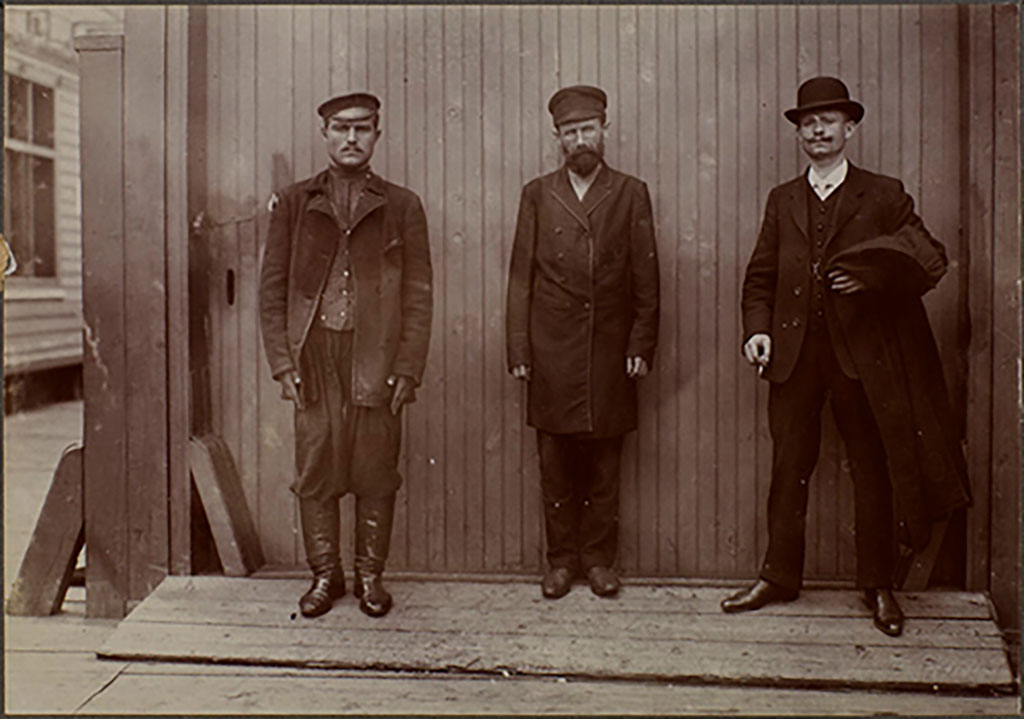by Jan Raska, PhD, Historian
(Updated October 9, 2020)
In May 2015, the Canadian Museum of Immigration at Pier 21 opened new exhibitions on the history of the Pier 21 National Historic Site of Canada and the history of immigration to Canada. This blog is based on research that informs new displays regarding the history of immigration to Canada.
Introduction
As part of the Museum’s new Core Exhibitions, Canada’s Immigration Story Gallery will inform visitors on the evolution of what Canadian officials have believed was ‘desirable’ in a prospective immigrant, and therefore, made them admissible. This exhibition will illustrate to visitors that the idea of desirability in immigration policy and practice continues to evolve along with Canadian culture, politics, and the economy.
The concept of admissibility remains a basic premise underpinning how Canada shapes immigration policy and immigrant selection. Successive Canadian Immigration Acts have developed a binary construction, listing qualities or circumstances that might trigger the admission or prohibition of an applicant. The descriptions “desirable” and “undesirable” are ascribed to applicants by Canadian authorities in light of immigration policy, and also personal judgement. Historically, race, ideology, country of origin, finances, occupation, health, gender, and many other factors have contributed to who officials deemed was – or was not – desirable. The latter were denied entry into Canada, thus excluded from beginning new lives in their chosen country of resettlement.
Since 1869 when the first Immigration Act was enacted, Canadian officials sought immigrants who were physically and mentally healthy, and whose character reflected Canadian values at the time of immigration. Most importantly, Canadian officials sought immigrants who could make a significant economic impact as highly sought-after labour. The type of immigrant Canadian officials desired was tempered by ethnoracial and geographic restrictions until the late 1960s. Health, character, and economics have had a significant influence on how the idea of admissibility has changed over time in Canadian immigration policy and practice. The following is a synopsis of relevant Canadian legislation and regulations that shaped the concept of ‘desirability’ from Confederation to today.
Canada’s first Immigration Act (1869)
The 1867 British North America Act (now the 1982 Constitution Act) outlined how the Dominion of Canada and its provinces would divide legislative powers. In section 95 of the 1867 act, the immigration portfolio was paired with agriculture, granting both the federal and provincial governments the ability to pass legislation pertaining to the movement of immigrants to Canada. The federal government retained constitutional jurisdiction over naturalization – the process in which a non-citizen who is a resident of Canada gains citizenship.[1] Two years later in 1869, Canada passed its first Immigration Act. Compared with later immigration legislation, the 1869 act set few restrictions on the movement of persons to Canada. However, the act ensured the safety of immigrants during their passage to Canada and protected them from exploitation upon arrival. The lack of restrictions on the movement of immigrants held a purpose: the Conservative government of Prime Minister John A. Macdonald promoted an open door immigration policy in an attempt to encourage settlement in Canada. However, during the latter half of the nineteenth century, the rate of emigration from Canada to the United States and Europe remained higher than the number of individuals seeking to permanently immigrate to Canada.[2]
Increasing Discretionary Powers for Immigrant Selection, Admission and Refusal
In 1906, the Canadian government enacted a new Immigration Act, the first major legislative overhaul pertaining strictly to immigration in almost four decades. An immigration policy was introduced that expanded the categories of prohibited immigrants. Under the new Act, inspecting officers at ports of entry had the authority to prohibit entry based on an applicants’ health, finances, or character. They also had discretionary authority to use some of the Act’s vague clauses to bar individuals who they deemed undesirable due to cultural background or ethnoracial identity.[3] The 1906 act was primarily used to prevent the entry of immigrants of African descent, Asians, political undesirables such as anarchists, mentally or physically disabled persons, and any individual likely to become a ‘public charge.’
Four years later, the Liberal government of Prime Minister Wilfrid Laurier expanded the list of prohibited immigrants and increased the immigration officials’ discretionary powers in selecting, admitting or preventing immigrants from entering Canada. The 1910 Immigration Act also made inadmissible individuals who were deemed to be unsuitable to Canada’s climate. The designation of “climatic unsuitability” was targeted primarily against racialized groups including applicants of African descent. This permitted Canadian officials to argue – speciously - that there was no “colour bar” in Canadian legislation. This kind of veiled, discretionary authority enjoyed increased protection from scrutiny under the 1910 act, as the federal and provincial judiciary was prevented from reviewing or reversing the rulings of the federal minister responsible for immigration.[4]
Streamlining the Administration of Immigration
The admission of thousands of European displaced persons and political refugees in the aftermath of the Second World War and during the early Cold War period forced the Canadian government to enact a new Immigration Act. Forty-two years after the Laurier government revised the centerpiece of immigration legislation, the Liberal government of Prime Minister Louis St. Laurent passed the 1952 Immigration Act. Similar to its predecessor from 1910, the new act streamlined the administration of immigration with the increasing numbers of displaced persons and refugees who were entering Canada.
The new act also gave wide-ranging powers – including “a large degree of uncontrolled discretionary power” – to the minister responsible for immigration.[5] The selection and admission of prospective immigrants were vested in a Governor-in-Council – in reality, the federal Cabinet who was represented by the minister of immigration. As a result of these changes, the federal Cabinet could deny entry to any individual on the basis of nationality, ethnic group, occupation, lifestyle – including homosexuality, drug use, drug trafficking, unsuitability to Canada’s climate, perceived inability to be readily assimilable, and ideology or personal belief – in particular, communism.[6] In essence, the government of Canada sought immigrants who supported its predominantly white, Christian, and middle-class values, and who could make a significant contribution to the economy as skilled labourers and professionals.[7]
The Liberalization of Immigration Policy
Officially known as Order-in-Council P.C. 1967-1616, the “points system” implemented new standards for the evaluation of prospective immigrants. In an effort to eliminate the subjective nature of immigrant selection by Canadian officials overseas, the new regulations enhanced the objectivity of admissions procedures by assessing immigrants using points in specific categories pertaining to occupational skills, employment history, education, proficiency in English and French, and personal character. Prospective immigrants who scored 50 points or more out a total of 100 were granted entry to Canada without any consideration of their ethnoracial identity or national origin.[8] The subjective or discretionary aspect of examination was not entirely removed: 15 points remained available to the inspecting officer to assign based on “personal suitability” of an applicant.[9]
Less than a decade later, the 1976 Immigration Act became the first Immigration Act since Confederation to outline the objectives of Canada’s immigration policy and as a result, was received favourably across Canadian society.[10] In recent years, the Canadian government has denied entry to immigrants deemed inadmissible under the following categories: security, human or international rights violations, criminality, organized criminality, health grounds, financial reasons, misrepresentation, non-compliance with the 2001 Immigration and Refugee Protection Act or having an inadmissible family member.[11]
Conclusion
Admissibility remains a powerful concept in Canadian immigration policy and practice. Since Confederation, the Canadian government has changed rules of admissibility to reflect changing attitudes towards immigrant groups. In many cases, individuals and groups were deemed as ‘desirable,’ while others were ‘undesirable.’ The latter were denied entry into Canada, thus excluded from beginning new lives in their chosen country of resettlement. Social and cultural changes have forced Canadian authorities to reimagine desirability and undesirability many times since Confederation. However, the basic elements of inclusion and exclusion – questions of health, character and economics - have remained consistent throughout more than a century of Canadian immigration policy and practice.

Credit: John Woodruff / Library and Archives Canada / C-009798
- Government of Canada (hereafter GOC), Justice Laws Website, “VI. Distribution of Legislative Powers,” accessed 23 April 2014, http://laws-lois.justice.gc.ca/eng/const/page-4.html
- Lindsay Van Dyk, “Canadian Immigration Acts and Legislation,” accessed 23 April 2014, /research/immigration-history/canadian-immigration-acts-and-legislation; Ninette Kelley and Michael Trebilcock, The Making of the Mosaic: A History of Canadian Immigration Policy (Toronto: University of Toronto Press, 1998), 62, 83; Reginald Whitaker, Canadian Immigration Policy since Confederation (Ottawa: Canadian Historical Association, 1991), 4.
- Van Dyk, “Canadian Immigration Acts and Legislation;” K. Tony Hollihan, “‘A brake upon the wheel’: Frank Oliver and the Creation of the Immigration Act of 1906,” Past Imperfect 1 (1992): 96, 106-107; Kelley and Trebilcock, Making of the Mosaic, 131-133; Barbara Roberts, Whence They Came: Deportation from Canada 1900-1935 (Ottawa: University of Ottawa Press, 1998), 57-58.
- Van Dyk, “Canadian Immigration Acts and Legislation;” Knowles, Strangers at Our Gates: Canadian Immigration and Immigration Policy 1540-2006 (Toronto: Dundurn Press, 2007), 85-86; Kelley and Trebilcock, Making of the Mosaic, 137-138.
- Knowles, Forging Our Legacy: Canadian Citizenship and Immigration, 1900-1977 (Ottawa: Public Works and Government Services Canada, 2000), 72-73; Van Dyk, “Canadian Immigration Acts and Legislation;” Kelley and Trebilcock, Making of the Mosaic, 314, 324-326; Freda Hawkins, Canada and Immigration: Public Policy and Public Concern (Montreal and Kingston: McGill-Queen’s University Press, 1988), 102-103.
- Knowles, Forging Our Legacy, 72-73.
- An unintended consequence of the new act was that it also significantly burdened the Minister’s office.
- Van Dyk, “Canadian Immigration Acts and Legislation;” Kelley and Trebilcock, Making of the Mosaic, 359-360; Knowles, Forging our Legacy, 84; Whitaker, Canadian Immigration Policy since Confederation, 19. See also Triadafilos Triadafilopoulos, “Dismantling White Canada: Race, Rights and the Origins of the Points System,” in Wanted and Welcome? Policies for Highly Skilled Immigration in Comparative Perspective, ed. Triadafilos Triadafilopoulos, 15-38 (New York: Springer, 2013).
- Hawkins, Canada and Immigration, 424. The department struggled with how to allocate those points in a way that was consistent with the attempted impartiality of the larger system. See Library and Archives Canada, Immigration Branch fonds (RG 76), vol. 938, file “Immigration Manual,” binder 18.
- Van Dyk, “Canadian Immigration Acts and Legislation;” Knowles, Strangers at Our Gates, 169-170; Kelley and Trebilcock, Making of the Mosaic, 372, 380; Freda Hawkins, Critical Years in Immigration: Canada and Australia Compared (Montreal: McGill-Queen’s University Press, 1991), 70, 73.
- Government of Canada, “Determine your eligibility – Immigrate to Canada,” accessed: 24 April 2014, http://www.cic.gc.ca/english/immigrate/eligibility.asp; Government of Canada, “Reasons for inadmissibility,” accessed: 24 April 2014, http://www.cic.gc.ca/english/information/inadmissibility/who.asp
